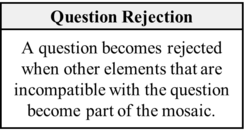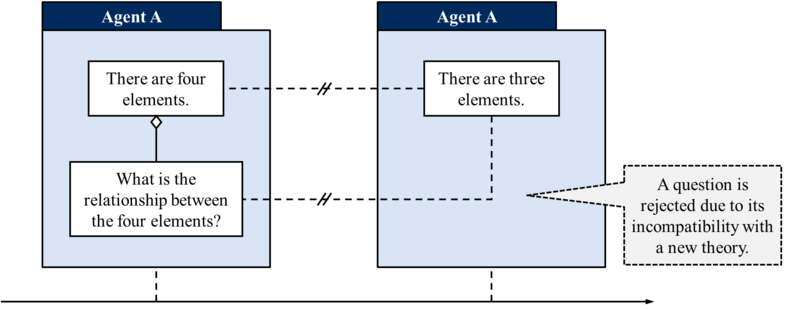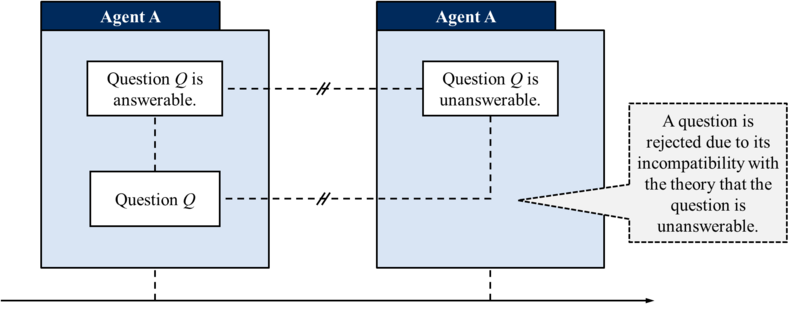Difference between revisions of "Question Rejection theorem (Barseghyan-Levesley-Pandey-2023)"
| Line 33: | Line 33: | ||
|Page Status=Stub | |Page Status=Stub | ||
|Editor Notes= | |Editor Notes= | ||
| + | }} | ||
| + | {{Acceptance Record | ||
| + | |Community=Community:Scientonomy | ||
| + | |Accepted From Era=CE | ||
| + | |Accepted From Year=2024 | ||
| + | |Accepted From Month=February | ||
| + | |Accepted From Day=22 | ||
| + | |Accepted From Approximate=No | ||
| + | |Acceptance Indicators=The theorem became accepted as a result of the acceptance of modification [[Modification:Sciento-2023-0002|Sciento-2023-0002]]. It replaced the [[Question Rejection theorem (Barseghyan-Levesley-2021)]]. | ||
| + | |Still Accepted=Yes | ||
| + | |Accepted Until Era= | ||
| + | |Accepted Until Year= | ||
| + | |Accepted Until Month= | ||
| + | |Accepted Until Day= | ||
| + | |Accepted Until Approximate=No | ||
| + | |Rejection Indicators= | ||
}} | }} | ||
Latest revision as of 11:05, 20 June 2024
This is an answer to the question Mechanism of Question Rejection that states "A question becomes rejected when other elements that are incompatible with the question become part of the mosaic."
This version of Question Rejection theorem was formulated by Hakob Barseghyan, Nichole Levesley and Aayu Pandey in 2023.1 It is currently accepted by Scientonomy community as the best available answer to the question.
Contents
Scientonomic History
Acceptance Record
| Community | Accepted From | Acceptance Indicators | Still Accepted | Accepted Until | Rejection Indicators |
|---|---|---|---|---|---|
| Scientonomy | 22 February 2024 | The theorem became accepted as a result of the acceptance of modification Sciento-2023-0002. It replaced the Question Rejection theorem (Barseghyan-Levesley-2021). | Yes |
Suggestions To Accept
Here are all the modifications where the acceptance of this theory has been suggested:
| Modification | Community | Date Suggested | Summary | Date Assessed | Verdict | Verdict Rationale |
|---|---|---|---|---|---|---|
| Sciento-2023-0002 | Scientonomy | 28 December 2023 | Accept new formulations of the first law for theories, norms, and questions that are in tune with the formulation of the first law. Also accept new formulations of the respective rejection theorems - theory rejection, norm rejection, and question rejection. | 22 January 2024 | Accepted | During the 2024 workshop, the bulk of the discussion centered around the inclusion of the first law for norms and norm rejection theorem in the set of formulations to be accepted. Paul Patton contended that norm employment in general had not been demonstrated to be lawful beyond method employment, and our basic formulations should instead concern norm acceptance, which is patently lawful. He argued that the formulations should be modified to pertain either to methods only or to norm acceptance. It was decided that if the community were to remain uncomfortable with accepting Pandey’s new formulations, a revote would likely also need to be taken on Rawleigh’s Sciento-2022-0002, given that the issue of norm employment was also highlighted in discussions of that modification. After extensive discussion, Barseghyan suggested that the first law for norms would only apply to situations where behavior was norm-guided to begin with, which would skirt the difficulty that faces even behavioural psychologists of determining whether human behaviour in general is lawful. The majority of the community was comfortable with this workaround, and the modification was ultimately accepted with over 2/3rds majority assenting, with 11/14 votes to accept (although 1 voter voted to reject the modification and 2 voted to keep it open). |
Question Answered
Question Rejection theorem (Barseghyan-Levesley-Pandey-2023) is an attempt to answer the following question: How do questions become rejected? What is the mechanism of question rejection?
See Mechanism of Question Rejection for more details.
Description
Pandey's formulation essentially preserves the gist of Barseghyan and Levesley's formulation but fixes its wording to ensure that the theorem actually follows from its premises. Like other scientonomic rejection theorems, the question rejection theorem assumes that questions become rejected as they get pushed out of an agent's mosaic due to their incompatibility with some newly accepted elements. There are two most common scenarios of such incompatibility.
In the first scenario, a question becomes rejected due to the acceptance of a new theory that happens to be incompatible with some of the question's epistemic presuppositions. As explained by Barseghyan and Levesley:
imagine an epistemic situation where agent A initially accepts the question “What is the relationship between the four elements?” together with the theoretical presupposition that there are four elements. Suppose also that at some later time the agent discovers that there are not four but three elements. Naturally, the agent rejects both the theory of four elements and the question about the relationships between these elements:
Importantly, this rejection happens regardless of whether it ever occurs to the agent to ask a new question “What is the relationship between the three elements?”. Even if the agent never accepts any further questions concerning the three elements, the question “What is the relationship between the four elements?” would still be rejected.2pp. 14-15
In the second scenario, a question is being rejected due to the acceptance of the second-order theory stating that the question is unanswerable (the latter being incompatible with the question). In the words of Barseghyan and Levesley:
Consider [an] epistemic situation, where agent A accepts some question Q, together with the theory that Q is answerable. When agent A comes to accept that Q is unanswerable, the agent rejects question Q. The scientonomic mechanism of this rejection is through the incompatibility of question Q and the theory “Question Q is unanswerable”:2p. 15
Reasons
No reasons are indicated for this theory.
If a reason supporting this theory is missing, please add it here.
Questions About This Theory
The following higher-order questions concerning this theory have been suggested:
If a question about this theory is missing, please add it here.
References
- ^ Pandey, Aayu. (2023) Dilemma of the First Law. Scientonomy 5, 25-46. Retrieved from https://scientojournal.com/index.php/scientonomy/article/view/42258.
- a b Barseghyan, Hakob and Levesley, Nichole. (2021) Question Dynamics. Scientonomy 4, 1-19. Retrieved from https://scientojournal.com/index.php/scientonomy/article/view/37120.


